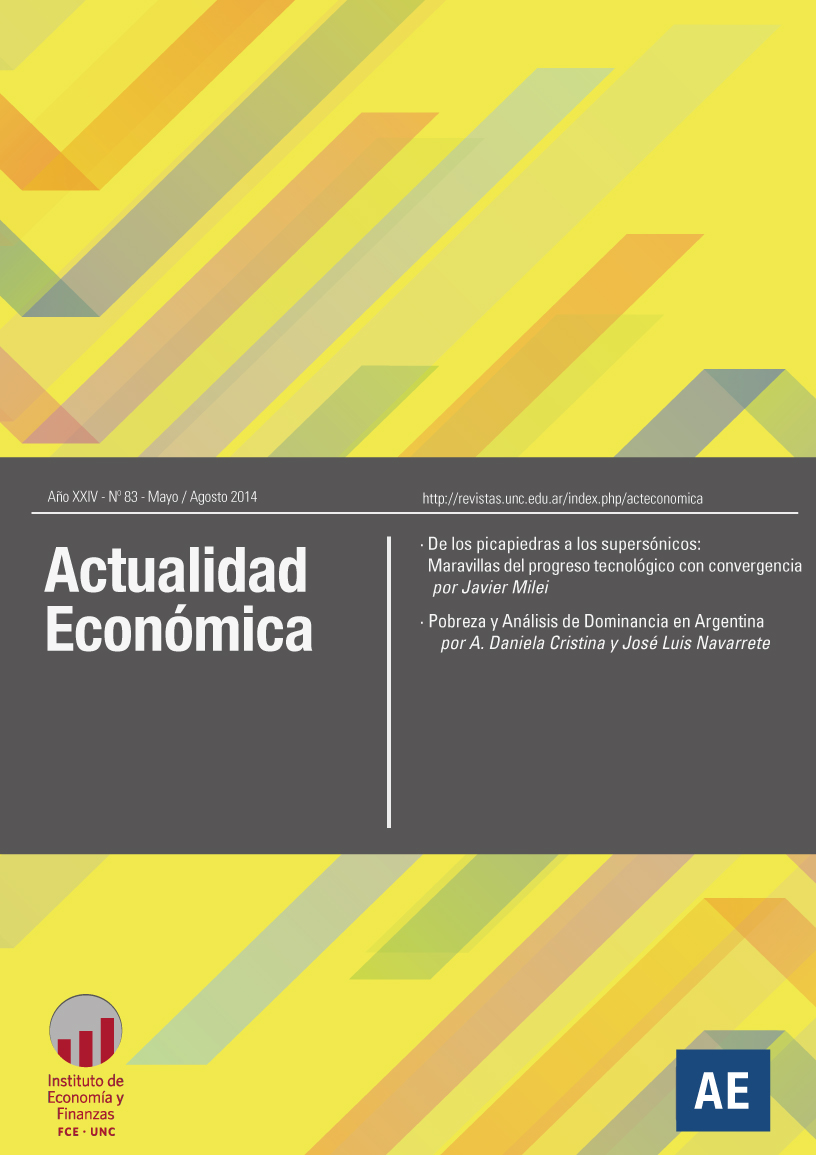Analysis Poverty and Dominance in Argentina
Keywords:
Absolute poverty, Relative poverty, Stochastic dominanceAbstract
This paper analyzes the evolution of poverty in Argentina and Gran Córdoba. The analysis shows that poverty has declined in urban areas and Gran Córdoba, although its magnitude depends of the poverty line used. To carry out unmistakable estimates of the evolution of poverty, the method of stochastic dominance is used to determine how poverty has evolved, observing its reduction in the relevant range.
Downloads
References
Atkinson, A. (1991). Comparing Poverty Rates Internationally: Lessons from Recent Studies in Developed Countries, World Bank Economic Review, Oxford University Press, vol. 5(1), pp. 3-21, Enero.
Beccaria, L. y Minujin, A. (1985). Métodos alternativos para medir la evolución y el tamaño de la pobreza, Documentos de Trabajo N° 6. INDEC.
Feres, J. (1997). Notas sobre la medición de la pobreza el método de los ingresos, Revista de la CEPAL, N°61.
Feres, J.C. y Mancero, X. (2001): “Enfoques Para la Medición de la Pobreza. Breve Revisión de la Literatura”, Serie Estudios Estadísticos y Prospectivos, Nº4.
Gasparini, L. (2004). Poverty and Inequality in Argentina: Methodological Issues and a Literature Review. CEDLAS. Universidad Nacional de La Plata
Gasparini, L. (2007). Monitoring the Socio-Economic Conditions in Argentina 1992-2006. CEDLAS. Universidad Nacional de La Plata
INDEC (1984). La pobreza en Argentina.
INDEC (1989). La pobreza en el conurbano bonaerense. Estudio N° 13, Buenos Aires.
Kakwani, Nanak (1980). On a Class of Poverty Measures. Econometrica, Vol. 48, No. 2 (Mar.), pp. 437-446.
Lanjouw, J. (1997). Behind the line: de-mystifying poverty lines, Yale University, Economics Department, mayo.
León, A. (1998). Las encuestas de hogares como fuente de información para el análisis de la educación y sus vínculos con el bienestar y la equidad, Serie Políticas Sociales 22, CEPAL.
Montoya, S. y M. Olivero (1998). Claves para reducir la pobreza agregada disminuyendo las disparidades regionales. Argentina 1990/97, Estudios N°85, Abril-Junio.
Observatorio de la Deuda Social Argentina, (2013): “Estimaciones de Tasas de Indigencia y Pobreza (2010-2012). Totales Urbanos”, Informe de Prensa, Pontificia Universidad Católica Argentina.
Pereyra, Liliana E. (2002). Pobreza en el Gran Córdoba. Actualidad Económica, Año XII, Nº 52 enero-julio.
Ravallion, M. (1995). Poverty Comparisons, LSMS, Working Paper Nº 122, World Bank, sección 2.7 y apéndice 2.
Schclarek Curutchet, A.; Gallo, P.; Torres, L. A. (2012) “El Índice Barrial de Precios: Construcción de un Indicador Socio-Económico de Manera Participativa y Transparente”, Actualidad Económica, Año XXI, Nº 73- Enero-Abril 2012.
Sen, A. (1981). Poverty and famines: An essay on entitlements and deprivation, Trinity College, Cambridge.
Sen, A. (1976). Poverty: an ordinal approach to measurement, Econométrica, Vol. 44, N° 2, Marzo.
Downloads
Published
Issue
Section
License
Those authors who have published with this journal, accept the following terms:
Authors will conserve their copyright and guarantee the magazine the right of first publication of their work, which will be simultaneously subject to the Creative Commons Attribution-NonCommercial-NoDerivative 4.0 International License that allows third parties to share the work as long as the author and first publication of this magazine are indicated.
Authors may adopt other non-exclusive license agreements to distribute the published version of the work (e.g., deposit it in an institutional telematic archive or publish it in a monographic volume) provided that the initial publication in this journal is indicated.
Authors are allowed and encouraged to disseminate their work through the Internet (e.g., in institutional telematic archives or on their website) before and during the submission process, which may lead to interesting exchanges and increase citations of the published work. (See The effect of open access)









